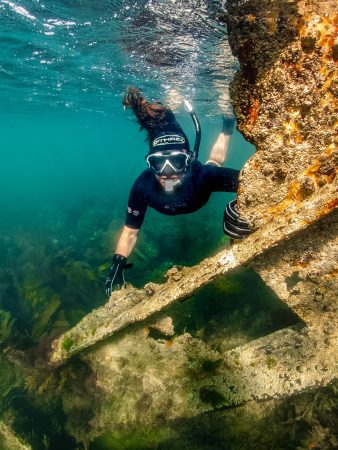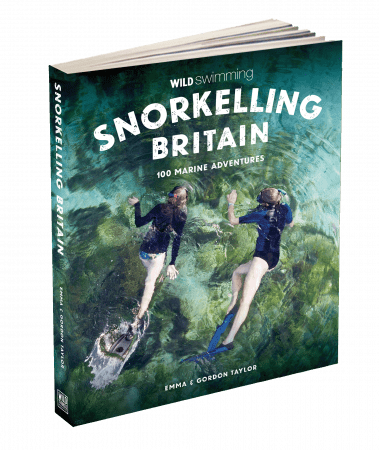Inspired by Emma & Gordon Taylor’s new book, ‘Snorkelling Britain: 100 Marine Adventures‘, we dive into the best shipwrecks in the UK for snorkellers.
Thanks to centuries of maritime trade, naval battles and a longstanding fishing industry, combined with some famously unpredictable coastal weather, the UK is home to one of the world’s largest collections of shipwrecks. From Victorian steamers to World War vessels and forgotten merchant traders, thousands of wrecks now rest just offshore, many in surprisingly shallow water. Today, these remnants of the past have taken on a new life beneath the waves, becoming fascinating playgrounds for snorkellers.
Shipwrecks and snorkelling in the UK
Shipwrecks act as artificial reefs, transforming the seabed into thriving underwater habitats. For snorkellers, that means every visit feels like an exploration: twisted metal, encrusted plates, and collapsed hulls form intricate structures, full of life.
Many UK wrecks come from the steam-powered era, so it’s common to see huge boilers lying abandoned on the seabed; you might even spot a conger eel peering out from deep inside the boiler tubes.
Mussels and anemones cling to every available surface. Peer into crevices and you may see spiny squat lobsters or even the striking blue of a common lobster. In the southwest, the curious tompot blenny is a regular sight, often found resting proudly on top of a wreckage.
Snorkelling around the UK’s shipwrecks offers a glimpse into a forgotten past, and makes for an unforgettable underwater adventure.
Churchill Barriers, St Mary’s, Orkney
The Churchill Barriers in Orkney aren’t just historic – they’re perfect snorkelling territory. Built to protect Scapa Flow during the World Wars, the barriers now hide sunken blockships that have become vibrant underwater habitats. Glide over rusty propeller shafts and boilers, all teeming with marine life, from colourful anemones and mussels to curious crabs and fish darting through the wreckage. Each of the four barriers offers something different, with unique structures to explore. Opinions are divided among local snorkellers as to which is the best, so take your pick; however, our authors have a particular soft spot for the eastern flank of Barrier 2.
The Juanita, Kirkwall, Ornkey
Exploring the Juanita is like visiting an historical monument that has been fully repurposed as a dense, living tapestry, offering a close-up look at how metal structures become thriving habitats beneath the waves.
The former oil tanker was originally scuttled as a blockship, later raised for salvage in 1949, and finally beached in the bay when her poor condition became clear while she was being towed to the scrapyard. Today, her almost-intact bow sits just a short swim from shore, making the wreck accessible, but still best enjoyed by experienced snorkellers.
Dropping into the water, you’re immediately met with a wreck completely taken over by life: anemones, limpets, sponges, seaweeds and a dense carpet of barnacles. Look closely and you’ll see the barnacles feeding, sweeping the water with their tiny comb-like limbs. The sheltered bay often allows a full circumnavigation of the wreck, giving snorkellers the rare chance to explore an historic vessel that has become a vibrant underwater reef.
Be mindful that conditions can vary on either side of the wreck and take care to minimise disturbance to the nesting Arctic Terns that call the Juanita home.
The Vera, Norfolk
The Vera, off Cley Beach in Norfolk, is a perfect destination for experienced snorkellers. The ship sank in 1914 following a collision and now rests upright on a sand and gravel seabed, 4 – 8 meters deep. Its remaining structure forms a striking artificial reef, with enough intact sections to reveal a ship-like outline when visibility is good.
Beneath the surface, the wreck is alive with marine creatures. Seaweeds coat the metal, while crabs, prawns, shannies, and gobies find shelter among the remains. Adventurous snorkellers can use a torch to spot lobsters or conger eels hiding in the darker recesses. Duck-diving helps explore the nooks and crannies, revealing this thriving underwater world.
Snorkellers must avoid swimming under or into the wreckage. There is a risk of damaging oneself, the wreck, or marine life if this safety rule is violated.
The Minx, Osmington Mills, Dorset
Once upon a time, the Minx was a steam-powered coal barge. Breaking lose from her moorings during a 1927 storm in Portland Harbour, she ran aground just west of Osmington Mills.
Today, her shallow, barnacle-encrusted wreck lies just meters from shore, often marked by a cormorant perched atop drying its wings.
The site is perfect for swimmers and experienced snorkellers, offering a rare close-up view of an artificial reef. From the surface, you can spot kelp-covered ribs and numerous other features, while duck-diving brings you one step closer to the abundant marine life. Tompot blennies perch on the wreck, whilst lobsters and conger eels linger in darker recesses. It’s a vibrant and exciting underwater world to explore.
Silver Steps, Falmouth, Cornwall
Silver Steps, on the southern side of Pendennis Point, offers easy access at most tides and is perfect for snorkelling, swimming and rock pooling. The site features the remains of six German U-Boats brought to Falmouth after World War I for explosives trials. Though heavily salvaged, enough wreckage remains to make snorkels interesting, with UB-86 the easiest to spot just 100 meters from the steps. Snorkellers can explore the rocky shoreline or swim out to nearby reefs.
The diversity of life here is exceptional – many seaweeds of all shapes and colours, gobies, wrasse, and perhaps even a conger eel or lobster hiding in the nooks and crannies of the wreckage.
Safety Tips for Snorkelling
Always snorkel with a buddy and, if possible, have someone onshore watching.
Assess your health and fitness before entering the water.
Ensure your snorkelling equipment is in good condition and you know how to use it.
Check site conditions carefully; tidal currents can be strong, especially near headlands and during spring tides.
If caught in a rip current, swim parallel to shore until free.
Avoid entering wrecks, caves, or underwater structures due to entanglement risks.
Use a swim buoy in areas with boat traffic.
Monitor for fatigue, cold, or immersion pulmonary oedema, exiting the water if needed.
Avoid polluted waters, especially within 24 hours after heavy rainfall.





